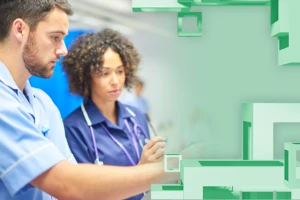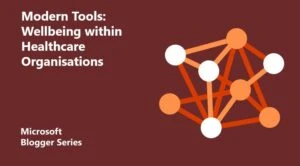
Cultivating collaborations with learner communities in Teams
 As a Learning Technologist, I work closely with our Faculty of Health and Wellbeing as digital learning lead, to effectively embed technology into learning and teaching practice. I am passionate about my work and find the collaboration between academic colleagues and technologists to be particularly rewarding.
As a Learning Technologist, I work closely with our Faculty of Health and Wellbeing as digital learning lead, to effectively embed technology into learning and teaching practice. I am passionate about my work and find the collaboration between academic colleagues and technologists to be particularly rewarding.
I became an MIE Expert last August after becoming more involved with the Microsoft Educator Community. At our institution, we have heavily invested in Microsoft technology solutions. This has seen us equip every member of academic staff with a Surface Pro and transform our learning spaces to support more innovative teaching methods. Office 365 has provided a suite of applications we have successfully embedded across the learner experience to setup e-portfolios, start online communities, and create more engaging and interactive learning materials. In March this year, I was fortunate enough to present at the Microsoft Transformational Technologies conference hosted at our institution. The presentation looked at the impact of using Microsoft Teams to create active learner communities within the School of Nursing. Fantastic feedback after the event highlighted that colleagues from other institutions have since been inspired to start running their own pilots with Teams. As an MIE Expert, I aim to showcase the work that we do, share good practice and hopefully inspire others to adopt new and innovative digital approaches.
My journey with Microsoft Teams
The introduction of Microsoft Teams as part of the Office 365 application suite has drastically changed the way in which learners can communicate, collaborate and access content online. In an age where smart phones are becoming the essential device for students, it is ever increasingly important to address their needs for much more accessible and instant learning experiences.
When students begin their journey, it is vital that they are able to connect with their peers and form meaningful relationships around their studies. For some students this can be challenging and there are number of different factors that can have effect.
Through a Faculty of Health and Wellbeing pilot, we have evaluated Teams’ effectiveness in student participation and the way in which learning has become much more accessible and able to take place outside the traditional classroom setting.
We were able to address two clear concerns for academic staff in relation to the learner experience:
- A drop in student engagement with existing chat/discussion tools available via the Universities VLE. Student expectations have shifted towards a much more instant and accessible learning experience that meets their needs.
- The creation of numerous social media sites (e.g. Facebook) linking to academic courses and groups. Usually brought about by students and sometimes staff, they have become increasingly difficult to police with no one quite knowing who has ownership. This leads to inconsistency across the student experience and puts staff and students in a difficult position; What if learners do not have an associated user account to engage with the platform? Supposing they do, what if they still don’t wish to interact with university groups in the same online space where they connect their own private social lives?
Teams provides a free to access mobile/desktop application which all students and staff automatically have access to through the universities Office 365 license. This platform promotes digital professionalism and provides an opportunity for learner’s voices to be heard in a secure and private environment.
 The accessible and appealing mobile interface of Teams has helped bring students together with staff, taking learning outside of the traditional ‘classroom’. The student buy-in lies with the parallels drawn between Teams and contemporary social media platforms. The new-look online communities galvanise the student learning experience by complementing the existing University VLE. Cohesion between these two core systems is key to overall engagement for both students and staff.
The accessible and appealing mobile interface of Teams has helped bring students together with staff, taking learning outside of the traditional ‘classroom’. The student buy-in lies with the parallels drawn between Teams and contemporary social media platforms. The new-look online communities galvanise the student learning experience by complementing the existing University VLE. Cohesion between these two core systems is key to overall engagement for both students and staff.
- “I can use it anywhere and I am able to share information quickly.”
- “It’s handy for supervision; I don’t have to travel to University.”
- “Accessibility and group support from peers.”
- “Keeping in touch and sharing ideas. It’s easy to use and navigate.”
- “The phone app is so easy to access! It’s useful for sharing information and seeking support.”
- “It’s good to get to know people before I started.“
- “Teams has allowed me to keep track of stages on the module and share questions or answers.”
- “Discussions could continue from lectures and it enabled group supervision at any time.”
- “Everyone is on the same page.”
- “Very good for communicating with lecturers.”
So, if you are looking for a platform to communicate, collaborate and share content with colleagues or learners – Teams has the answer!
[msce_cta layout=”image_center” align=”center” linktype=”blue” imageurl=”https://www.microsoft.com/en-gb/industry/blog/wp-content/uploads/sites/22/2019/01/Two-female-and-one-male-student-on-the-go-walking-outdoors.png” linkurl=”https://www.microsoft.com/en-gb/education/products/teams/default.aspx” linkscreenreadertext=”Meet Microsoft Teams” linktext=”Meet Microsoft Teams” ][/msce_cta]
 About the author
About the author
Chris is a higher education professional possessing extensive skills and experience across a broad range of digital approaches and applications to learning, teaching, and assessment. With particular emphasis on collaborative tools, mobile technologies, video capture and virtual learning environments. He is passionate about enhancing teaching and learning through staff development and collaboration, playing an instrumental role in the deployment of Microsoft Surface technology and Office 365 at UCLan. Follow him on twitter.




